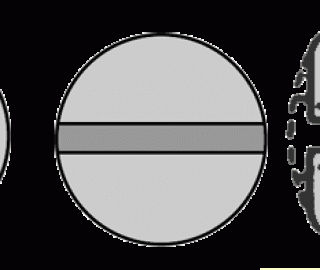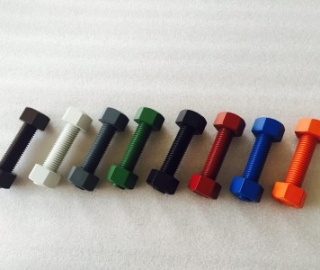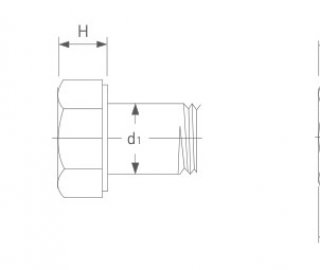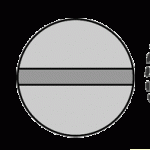 A washer is a thin plate (typically disk-shaped) with a hole (typically in the middle) that is normally used to distribute the load of a threaded fastener, such as a screw or nut. Other uses are as a spacer, spring (Belleville, wave washer), wear pad, preload indicating device, locking device, and to reduce vibration (rubber washer). Washers usually have an outer diameter (OD) about twice the width of their inner diameter (ID).
A washer is a thin plate (typically disk-shaped) with a hole (typically in the middle) that is normally used to distribute the load of a threaded fastener, such as a screw or nut. Other uses are as a spacer, spring (Belleville, wave washer), wear pad, preload indicating device, locking device, and to reduce vibration (rubber washer). Washers usually have an outer diameter (OD) about twice the width of their inner diameter (ID).
Washers are usually metal or plastic. High quality bolted joints require hardened steel washers to prevent the loss of pre-load after the torque is applied.
Rubber or fiber gaskets used in taps (or faucets, or valves) to stop the flow of water are sometimes referred to colloquially as washers; but, while they may look similar, washers and gaskets are usually designed for different functions and made differently.
Washers are also important for preventing galvanic corrosion, particularly by insulating steel screws from aluminum surfaces.
Washers can be categorized into three types;
- Plain washers, which spread a load, and prevent damage to the surface being fixed, or provide some sort of insulation such as electrical
- Spring washers, which have axial flexibility and are used to prevent fastening loosening due to vibrations
- Locking washers, which prevent fastening loosening by preventing unscrewing rotation of the fastening device; locking washers are usually also spring washers.
The American National Standards Institute (ANSI) provides standards for general use flat washers. Type A is a series of steel washers with broad tolerances, where precision is NOT critical. Type B is a series of flat washers with tighter tolerances where outside diameters are categorized as ‘Narrow’, ‘Regular’ or ‘Wide’ for specific bolt sizes.
Type’ is not to be confused with ‘form’ (but often is). The British Standard for Metric Series Metal Washers (BS4320) written in 1968 coined the term ‘form’. The forms go from A to D for Bright Metal and denote outside diameter and thickness. They can be summarised as –
- Form A: Normal diameter, normal thickness
- Form B: Normal diameter, light thickness
- Form C: Large diameter, normal thickness
- Form D: Large diameter, light thickness
- Forms E to G relate to black metal washers.
Plain washers
A plain washer (or ‘flat washer’) is a flat annulus or ring, often of metal, used to spread the load of a screwed fastening. Additionally, a plain washer may be used when the hole is a larger diameter than the fixing nut
A fender washer is a flat washer with a particularly large outer diameter in proportion to its central hole. They are commonly used to spread the load on thin sheet metal, and are named after their use on automobile fenders. They can also be used to make a connection to a hole that has been enlarged by rust or wear.
A penny washer is a flat washer with a large outer diameter, in the UK. The name originally comes from the size of the old British penny. In the UK, most industries refer to all large OD washers as penny washers, even when the OD is as much as twice the size of the old penny. They are used in the same applications as fender washers.
A spherical washer is part of a self-aligning nut; it is a washer with one radiused surface, which is designed to be used in conjunction with a mating nut in order to correct for up to several degrees of misalignment between parts.
An anchor plate or wall washer is a large plate or washer connected to a tie rod or bolt. Anchor plates are used on exterior walls of masonry buildings, for structural reinforcement. Being visible, many anchor plates are made in a style that is decorative.
A torque washer is used in woodworking in combination with a carriage bolt; it has a square hole in the centre which the carriage bolt square fits into. Teeth or prongs on the washer bite into the wood preventing the bolt from spinning freely when a nut is being tightened.
Spring and locking washers
Belleville washers, also known as cupped spring washers or conical washers, have a slight conical shape, which provides an axial force when deformed.
A curved disc spring is similar to a Belleville, except the washer is curved in only one direction, therefore there are only four points of contact. Unlike Belleville washers, they exert only light pressures.
Wave washers have a “wave” in the axial direction, which provides spring pressure when compressed. Wave washers, of comparable size, do not produce as much force as Belleville washers. In Germany, they are sometimes used as lock washers, however they are less effective than other choices.
A split washer or a spring lock washer is a ring split at one point and bent into a helical shape. This causes the washer to exert a spring force between the fastener’s head and the substrate, which maintains the washer hard against the substrate and the bolt thread hard against the nut or substrate thread, creating more friction and resistance to rotation. Applicable standards are ASME B18.21.1, DIN 127B, and United States Military Standard NASM 35338 (formerly MS 35338 and AN-935).Spring washers are a left hand helix and allow the thread to be tightened in a right hand direction only, i.e. a clockwise direction. When a left hand turning motion is applied, the raised edge bites into the underside of the bolt or nut and the part that it is bolted to, thus resisting turning. Therefore spring washers are ineffective on left hand threads and hardened surfaces. Also, they are not to be used in conjunction with a flat washer under the spring washer, as this isolates the spring washer from biting into the component that it is fastening. Where a flat washer is required to span a large hole in a component, a nyloc nut (nylon insert) must be used. The use and effectiveness of spring lock washers has been in debate of late, with some publications advising against their use on the grounds that, when tight, the washer is flat against the substrate and gives no more resistance to rotation than a normal washer at the same torque. However, a spring washer will continue to hold the bolt against the substrate and maintain friction when loosened slightly, whereas a plain washer will not.
A toothed lock washer, also known as a serrated washer or star washer, has serrations that extend radially inward or outward to bite into the bearing surface. This type of washer is especially effective as a lock washer when used with a soft substrate, such as aluminum or plastic, and can resist rotation more than a plain washer on hard surfaces, as the tension between washer and the surface is applied over a much smaller area (the teeth). There are four types: internal, external, combination, and countersunk. The internal style has the serrations along the inner edge of the washer, which makes them more aesthetically pleasing. The external style has the serrations around the outer edge, which provides better holding power, because of the greater circumference. The combination style has serrations about both edges, for maximum holding power. The countersunk style is designed to be used with flat-head screws.
Tooth lock washers are also used for ground bonding where a metal lug or object must be electrically bonded to a surface. The teeth of the washer cut through surface oxides, paints or other finishes and provide a gas-tight conductive path. In these applications the washer is not placed under the head of the screw (or under the nut), it is placed between the surfaces to be bonded. In such applications, the tooth washer does not provide any anti-rotation locking features.
We made bolts, nuts, and washer. If you are interested in our company, please feel free to contact us.
Sourced by ekomeri






